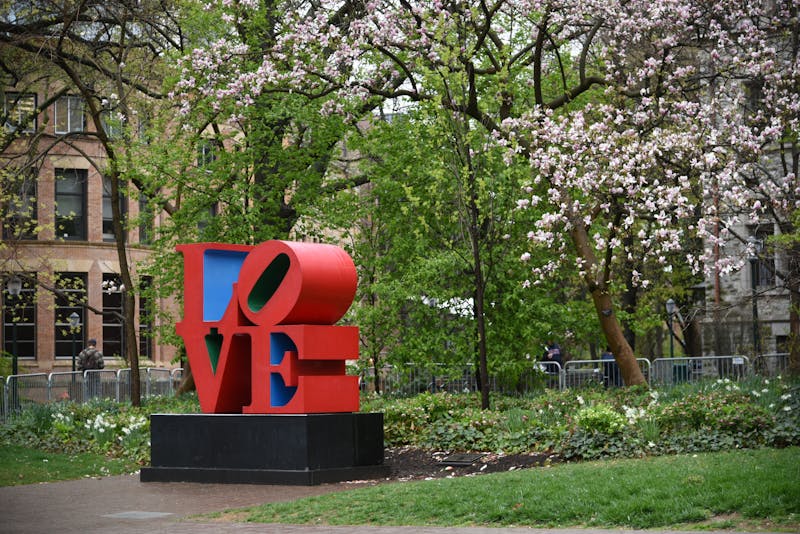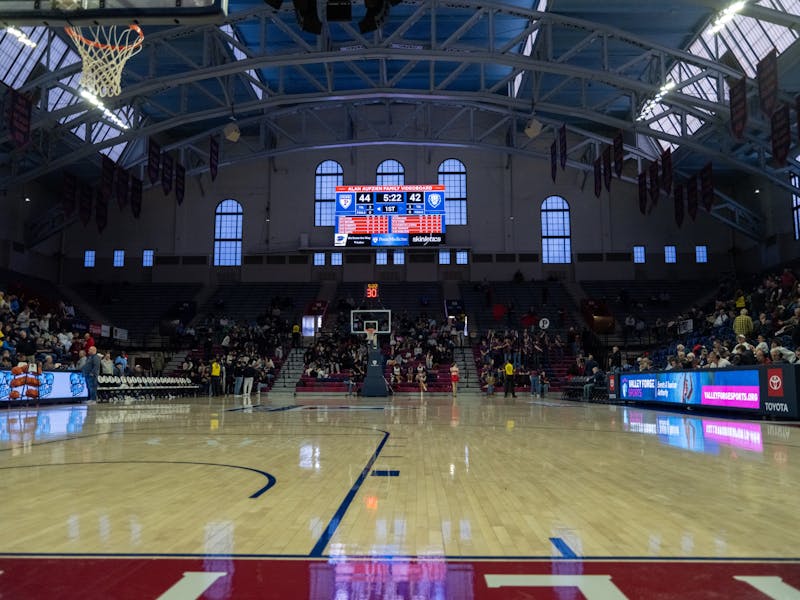Tupac Shakur once noted, “Things changed, and that’s the way it is.”
Things may never be the same for Penn heavyweight rowing, as the program has undergone a near-complete overhaul of the coaching staff. At the conclusion of the 2015 season, previous men’s coach Greg Myhr’s contract was not renewed after six years in University City.
However, in its first season with the program, the new staff is looking to bring Penn rowing — a storied program dating back to 1854 — back into the national spotlight.
New head coach Geoff Bond and assistant coach Brandon Shald brought their talents to Penn from the University of California, Berkeley, a perennial rowing powerhouse. Bond’s tenure at Cal stretched nine years, during which he coached five boats to national titles at the Intercollegiate Rowing Association Championships and three freshman boats to IRA titles. Shald not only served as an assistant coach for Ivy rival Princeton, but also has a national title under his belt from his time at Cal — where he was coached by none other than Bond.
The heavyweight men have enjoyed the tenure of several legendary coaches such as Ted Nash — who participated in 10 total Olympic games as both an athlete and coach — and Joe Burk, once known as the “world’s greatest oarsman,” who coached the Quakers to both multiple IRA championships and nearly to an Olympic appearance in 1968.
However, the last IRA win for the Red and Blue heavyweights came in 1991. Despite not being a heavily decorated program in the past two decades, Bond hopes to usher in an era of higher standards and higher finishes on the national stage for the heavyweights.
Turning fine boys into good men
Standing in the boat bay of 11 Boathouse Row, Bond gestures to the banners hanging above the rows of racing shells, ruffled slightly by the breeze coming off of the Schuylkill. The red and blue banners catalogue the years of IRA wins and Eastern Sprints championships, serving as a reminder of former victories for the heavyweights — and perhaps as an indicator of what could come.
“This place — look at these banners on the ceiling. There have been generations of men here who have made boats go as fast as any in the country, or the world. That’s what Penn’s done, and that’s what Penn should do. This place with its rich tradition and great alumni base should be competitive with anyone.”
However, hanging more banners from the rafters of Penn’s boathouse will take buying into a very different system than in years past. Bond is bringing in a technical focus that previously fell to the wayside for the heavyweights.
Under legendary coach Steve Gladstone — first as an oarsman himself at Brown and then as part of Gladstone’s staff at Cal — Bond developed a strong conceptual and technical knowledge of the sport. Implementing the stroke technique learned under Gladstone and reforming the way the Quakers’ crew rows is foremost for Bond.
“The technical tradition goes back a lot of generations,” he said. “In terms of the stroke pattern, that’s consistent and cohesive with what I’ve learned back in the day. I’m a big fan of being able to use your body weight and being a skilled all-around athlete. The foundation was laid at Brown and I’ve taken it with me wherever I’ve coached.”
Though Bond’s vision and strategies may be steadfast, it’s no easy task to completely reform the way 41 athletes go about moving a boat. Not only was the challenge a physical one, but one of conforming competing mindsets to a unified goal.
“The human ego is what it is. It gets comfortable and gets used to doing something a particular way,” he said. “My job as a coach is bringing the guys where they need to be — to have a strong presence and to be unyielding in terms of my vision and what I’m trying to accomplish. Any resistance is only because they’re used to doing something a certain way.”
The oarsmen were largely receptive to the rapid changes Bond brought about, though their adaptation, technical or otherwise, was not all smooth sailing.
“In terms of the nuances of the technical instruction, it was new to them, and I think a little bit confusing. There were very few — they’re gone now — guys who were resistant. I think perhaps they were puzzled by some of what was being coached, but they were by and large receptive.”
Though some team members chose to leave the program after not meshing well with Bond’s approach, those who remained had the receptive mindset necessary to function under a new system. Bond emphasizes trust and respect, both among the team and in the boat.
“If you’re going to be a team you’re going to need to trust one another,” he said. “It’s not about ‘like.’ We’re socially hardwired to deal in ‘like’ and that has nothing to do with [rowing]. It comes down to trust and respect, and when you’re down to the final 30 strokes of the race, I need to trust that man in front of me so I only have to worry about myself. That trust is built over time, by working, failing, and succeeding together.”
Bond has also brought an international focus to recruiting.
“Though Juniors Rowing in the U.S. is very popular, there are not enough top of the line recruits coming out of the U.S. Juniors program to satisfy the needs of the top rowing programs.”
In a truly Wharton-like statement, Bond likened the recruiting pool to global economics.
“It is a market, and you have to make sure you’re recruiting globally. Our percentage of international guys is lower than our competitors’. A young man from Serbia comes from a place where rowing is really valued and a lot of people work very hard at it, and he’ll be of great value to a crew.”
The most interesting man in the world
It’s not every day that a coach was both a professional ballet dancer and a U.S. Rowing National Team prospect. But Brandon Shald isn’t your everyday assistant coach.
When Shald was 19, he performed as the lead in Balanchine’s Concerto Barocco ballet, earning glowing reviews in publications such as the San Francisco Chronicle, who lauded him as a “very musical and sensitive partner.”
Just three years later as a freshman at Cal under Bond’s tutelage, he traded in his tights for trou, and was racking up prestigious wins at races like the Royal Henley Regattaand the Head of the Charles Regatta, eventually winning a national title in the Freshman 8.
Growing up on a farm in rural Nebraska, Shald’s first athletic endeavors were on horseback. It was through his younger sister that he gained his first exposure to ballet; after she came home after her own ballet lessons. Shald, always the dutiful younger brother, inquired after what she had learned, at times replicating the moves she demonstrated to him.
After encouragement from his grandfather, Shald eventually pursued — and excelled — at dance, both relocating to Spain to pursue his passion and spending four years training and performing with the San Francisco Ballet School.
“It was one of those things that was pretty awesome, the combination of music and movement,” he explained. “It grabbed me from that first day pretty much until I decided to stop.”
After his retirement from dance, Shald decided to stay in California to attend college at UC-Berkeley. Cal is a school with a storied history of rowing, and for an athlete like Shald, who stands at 6-foot-6, it was only a matter of time before he would cross paths with rowing.
“It was something about being in the Bay Area, you’re surrounded by water,” he said. “People are rowing past your house in singles. When I stopped doing ballet, I was looking for something physical to do — my dad didn’t want me to get fat and out of shape — rowing was something always available to me. I checked out a local boathouse and got connected through coaches [to Cal].
“I just hopped in a boat and the rest was history.”
For Shald, his background in dance served him well as an oarsman. The demanding nature of both sports, as well as the kinesthetic awareness and bodyweight strength Shald developed through ballet, gave him an advantage in the boat.
“Flexibility and rhythm is the most obvious thing that helps. But body control, manipulating it and putting it in positions that coaches are looking for — sometimes you’ll go and tell guys to put their shoulders down and they can’t, though it’s pretty simple. That made the transition easy.”
Working with Bond for a second time in his career — this time as his assistant coach rather than his athlete — has made Shald’s transition to Penn almost as easy as his transition from dance to rowing.
The best time of his life
“My best time rowing in college was freshman year because of [Bond] and the guys I rowed with. Those friendships that were formed and the total experience of life — freshman year was the greatest year and I get to relive it every day, and that’s pretty special.”
Shald’s experience with Bond, as both an athlete and now as his assistant coach, makes for a staff that is cohesive in their approach.
“The biggest thing we’re bringing — all of us — is attention to detail, every detail. From taking the oars down in the morning, to setting the boats gently in the water, to the first stroke off the dock. Everything has to have a purpose. With purpose and attention to detail fast boats will happen.”
Rowing, for Shald, isn’t just his current job or a source of memories from his own career. The sport permeates his whole life, even in the personal realm. Caroline Lind, Shald’s wife, is a two-time Olympic gold medalist for the United States in the Women’s 8, world record holder and multiple time Senior National Team member. Shald cites her as one of his biggest inspirations in and out of the sport.
“She’s seven months out of back surgery and still trying to make this Olympics. The thing that I find that I’m fortunate with is that she understands and knows rowing, and how hard I work, and of course her own work ethic.”
After Shald’s time as a collegiate rower, he spent time at the Olympic Training Center in Princeton, attempting to make the Olympic boat. Though he fell short of his goal, he still brings the experience and lessons accumulated over a career spent in the highest levels of the sport.
“We’re finding ways to get good work in,” he said. “Penn hasn’t won big races in a while — but coming here with the idea of building something, and bringing the things I’ve leaned from the national team coaches, from coaches like Bond and Gladstone, that’s what we’re here to do, to build something.
“We have to come off every race having learned something, come off the water after practice having learned something, ask if we’ve bettered our teammates and bettered ourselves.”
The Boys in the Empachers
In the shadow of the Palestra, Hutchinson Gymnasium houses the rowing programs during the bleak winter months when the Schuylkill freezes over and the dropping temperatures prevent the oarsmen from training on the river. In the basement, the team labors away on ergs, waiting for spring and the chance to go to work on the open water.
It is in this facility that the rowers have put in the most hours and spent the most time with the new staff, adjusting to both new ways of training and new styles of coaching — even new equipment. This year, the team gained new racing shells, Empachers, whose signature fluorescent yellow skin and masterful German engineering have made them popular among crews worldwide.
Adjusting to the new staff in tandem with the demands of winter training was difficult for the heavyweight oarsmen but not impossible, according to senior captain Connor Davenport.
“At the beginning of the year it was a difficult transition,” Davenport said. “But we had a team full of guys who were willing to work hard and do it.
“Coach Bond takes a very technical approach, whereas Myhr didn’t. From day one there was a way [Bond] wanted us to row, everything from your posture in the boat, to the length of the slide, to what the drive looks like — that’s been the main thing for guys, being in line with what he wants while still going hard on the pieces and on the erg.”
In addition to the physical and mental challenges the oarsmen faced over the winter, they gained an understanding of what simply makes a boat go fast.
Senior Diego Fiori, though in his final year on the team, found himself learning new caveats from Bond.
“There’s a lot of places to find speed, and we have to get it from every place we can find,” Fiori said. “That means pushing our fitness numbers, getting technique down to a flawless degree, and then all the other things that go into performing your best.”
Even with experience from the world stage, senior coxswain Jake Mendelson — who coxed for the senior national team in Aiguebelette, France, this past summer — has found himself learning valuable lessons from Bond.
“I’ve learned a lot about the stroke and learned so much about physics, how boats move, how human bodies move, and how to exert the most out of a body,” he noted.
Physics wasn’t the only thing in which Mendelson got a crash course. Learning a new mindset for the team and setting the tone for a team culture more compatible with higher expectations was another thing Bond brought that Mendelson, as a coxswain, had to instill in his team.
“Even with team dynamic, our old culture wasn’t explicitly written,” Mendelson said. “With the new coach, we stated who we wanted to be and he’s taught us to be that in everything we do.
“We have to be cohesive in everything we do. It’s almost abrasive — if there’s something we don’t like, we call it out — if you’re not holding others to the highest standard, then what are you holding yourself to?”
Creating consistently winning crews is a lengthy and multi-year process, one that requires the right combination of strong recruits, near technical perfection, trust in one’s teammates and hours of work on and off the water. The present oarsmen serve as the foundation for the future, and Bond looks to get all the speed he can from his current crew.
“This year, we’re on track, the quality of rowing is dramatically improved. We have enormous strides to make physiologically, getting tougher and getting fitter, we’re still not quite there, but that development will come.
“In terms of boat speed, I’m not a prognosticator — I know we’re getting better and we’re going to be as fast as we’re capable of being.”
The Daily Pennsylvanian is an independent, student-run newspaper. Please consider making a donation to support the coverage that shapes the University. Your generosity ensures a future of strong journalism at Penn.
DonatePlease note All comments are eligible for publication in The Daily Pennsylvanian.









